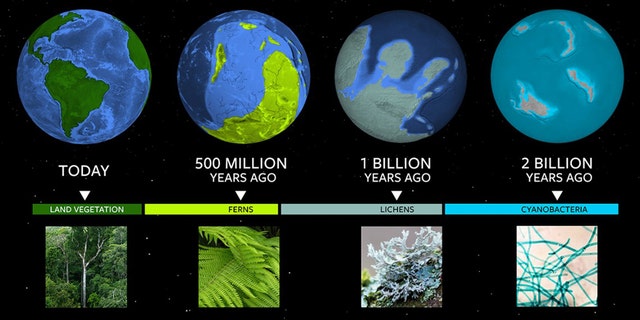Fox News Flash top headlines for July 12
Fox News Flash top headlines for July 12 are here. Check out what’s clicking on Foxnews.com
Despite our best efforts, humanity has yet to find the existence of intelligent extraterrestrial life. So, we've decided to cheat.
Astronomers at Cornell University have created what they call a "cosmic cheat sheet," utilizing nature's color palette from the early days of the planet in an effort to better find alien planets that could potentially host life.
“In our search to understand exoplanets, we’re using the early Earth and its biological milestones in history as a Rosetta stone,” said Jack O’Malley-James, a research associate at Cornell’s Carl Sagan Institute, in a statement.

To understand where exoplanets are in their own evolution, astronomers can use Earth’s biological milestones as a Rosetta stone. (Credit: Wendy Kenigsberg/Cornell Brand Communications)
The graph has four distinct colors representing various flora and fauna — dark green, which marks land vegetation; light green, which signifies ferns; grey is equated to lichens; and aqua, which is representative of various cyanobacteria.
“When we discover an exoplanet, this research gives us a much wider range to look back in time,” Lisa Kaltenegger, a professor of astronomy and director of the Sagan Institute and the study's co-author, said. “We extend the time that we can find surface biota from 500 million years (widespread land vegetation) to about 1 billion years ago with lichen and up to 2 or 3 billion years ago with cyanobacteria.”
The Earth is generally assumed to be roughly 4.7 billion years old, utilizing radioactive dating that uses uranium decay, according to NASA.
“If an alien had used color to observe if our Earth had life, that alien would see very different colors throughout our planet’s history – going back billions of years – when different life forms dominated Earth’s surface,” Kaltenegger added.
O'Malley added that scientists are able to look at biosignatures on "Earth-like exoplanets" using the history of our planet, thanks to the research he and Kaltenegger have done.
The study has been published in the Astrophysical Journal.
CLICK HERE TO GET THE FOX NEWS APP
Source: Read Full Article
